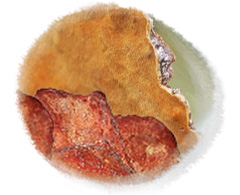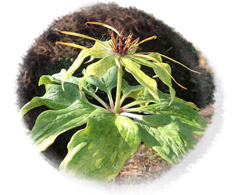
Research

Notoginseng gets its name from the fact that each of its three (san) gives rise to seven (qi) leaves. According to another account, it gets its name from the fact that it can be harvested after 3 to 7 years. Also known by many other names, Notoginseng is a perennial plant that belongs to the family Araliaceae and the genus Panax. It has sprawling, spindle-shaped, meaty roots and rhizomes that may be either short or long. The plant's palm-shaped compound leaves are arranged in a whorl around the end of each stem, and there are 3-7 leaflets. A cluster of spherical red fruit is borne at the center of the plant. Notoginseng grows in the mountains of China's Yunnan and Guangxi provinces. It has been used since ancient times as a treatment for injuries, and is the main ingredient in the medication Yunnan Baiyao. The active components in Notoginseng consist of ginsenosides, which chiefly include the ginsenosides Rb1, Rb2, Rb3, Rc, Re, Rf, Rg1, Rg2, and Rh1. Researchers found that Notoginseng's total saponin content is approximately 12%, which is even more than in ginseng.

Antrodia cinnamomea is a species of fungus native to Taiwan with medicinal uses. It exists only as a parasite on stout camphor trees, and is the only type of wood-rotting fungus that has been discovered on stout camphor trees. It is a member of the family Polyporaceae and the genus Antrodia. The stout camphor tree is a large evergreen broadleaf tree native to Taiwan; it is currently classified as a Type I protected tree species, and is very rare, which has also increased the rarity of Antrodia cinnamomea. Antrodia cinnamomea resembles Ganoderma fungus in shape; and is salmon in color. Taiwan's indigenous peoples used this fungus to treat hangovers, and research has proven that its active substances (triterpenoids, polysaccharides) are found in concentrations several dozen times greater than those in Ganoderma, which accounts for Antrodia cinnamomea's extremely great value and medicinal effectiveness. Because wild Antrodia cinnamomea is so rare and costly, most Antrodia products currently on the market are derived from artificial culture of the fungus. Artificial culture methods include solid culture, liquid culture, and culture on basswood, and the resulting product consists of mycelium and fruiting bodies.

The Paris polyphylla is a member of the Lilaceae, and belongs to the family Trilliaceae and the genus Paris. This plant gets its name from the fact that its 7-10 leaves are arranged in a whorl at the end of the plant's stem, and the single flower is located above the whorled leaves. The oblate, columnar root has nodes and is slight curved; the thick, protruding rings resemble sleeping fleas or the floors of a building, which accounts for some of its local names. According to Li Shizhen's Compendium of Materia Medica: "The Paris polyphylla dwells in the deep mountains, and is able to cure warts and carbuncles." The Paris polyphylla is a very rare and valuable plant; it can eliminate heat, detoxify the body, cool the liver, and relieve anxiety. It chiefly grows in Taiwan and China's Guizhou, Yunnan, Tibet, and Sichuan areas.
 Facebook
Facebook







